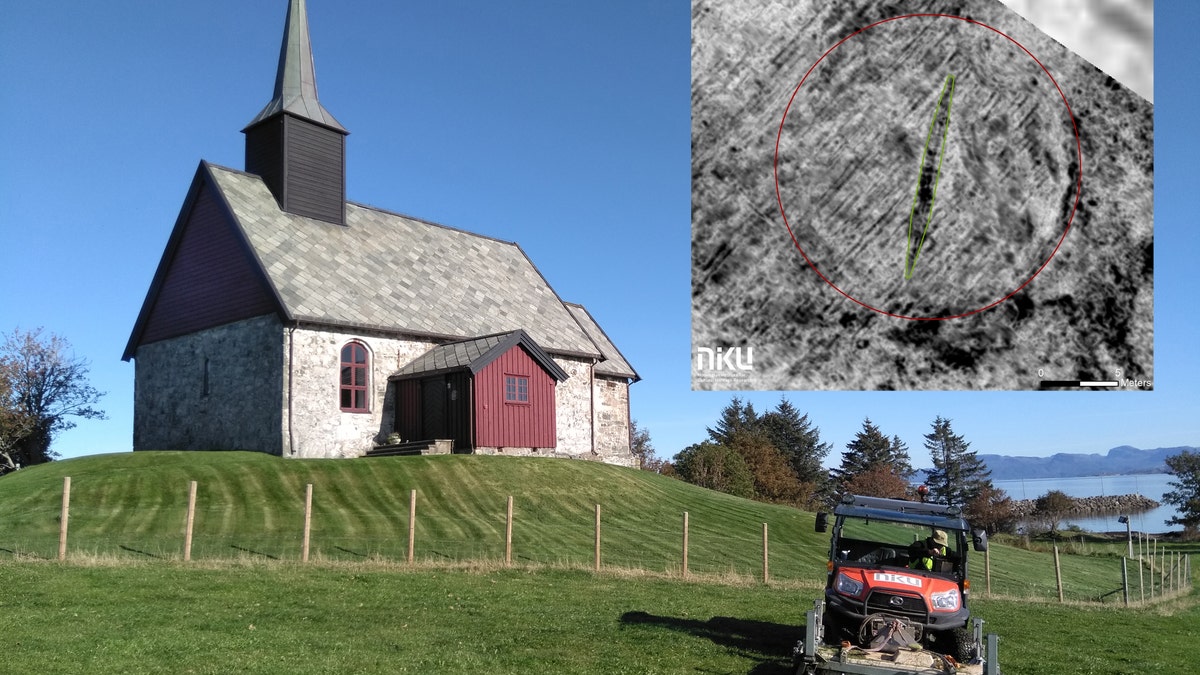Fox News Flash top headlines for Nov. 25
Fox News Flash top headlines for Nov. 25 are here. Check out what's clicking on Foxnews.com
Archaeologists in Norway have used radar technology to discover a 1,000-year-old buried Viking ship.
Researchers have spotted a 43-foot keel just beneath the topsoil of a burial mound on the island of Edøy in western Norway. The fore and aft sterns, however, appear to have been destroyed by plowing, and the ship is thought to have once been up 56 feet long.
The discovery was made by experts from the Norwegian Institute for Cultural Heritage Research (NIKU), using high-resolution georadar developed by the Ludwig Boltzmann Institute for Archaeological Prospection and Virtual Archaeology (LBI ArchPro).
MYSTERIOUS DOUBLE VIKING BOAT BURIAL DISCOVERED
In a statement, Knut Paasche, Ph.D., head of the department of digital archaeology at NIKU, explained that only three well-preserved Viking ship burials are known in Norway, all of which were excavated a long time ago. The ship will be of great historical significance, he added.

Georadar scanning at Edøy church. (NIKU)
The ship is from the Merovingian or Viking period and more than 1,000 years old, according to Paasche.
However, it is not yet known whether human remains and Viking artifacts are located within the buried ship, although they have been found at other ship burials.
VIKING LONGSHIP DISCOVERY THRILLS ARCHAEOLOGISTS
“The survey [at Edøy] has been purely non-intrusive,” a spokesman for NIKU told Fox News. “Our equipment is getting better, so we can be pretty sure of what we have here. On top of that, the island itself is smack in the middle of Merovingian and Viking activity more than a thousand year[s] ago. The locals were really happy with the find - but not really surprised.”

The buried Viking ship at Edøy. (NIKU)
The spokesman added that it’s a little too early to predict future excavations at the site. “It will depend on the state of the ship. There will probably be a probe-excavation to see if there is anything left at all and the state of the soil.”
“Do we need to dig up everything?” the spokesman added. “We can do a lot more with non-intrusive instruments now that we know the exact location.”
'SENSATIONAL' VIKING BOAT GRAVES DISCOVERED
Archaeologists have also spotted traces of settlements in their data, but say that it is too early to date them.
Viking-era discoveries have thrilled archaeologists across the Nordic countries, the Baltic and Scotland in recent years. A mysterious double Viking boat burial, for example, was recently discovered in Norway, intriguing experts.
Last month, archaeologists excavating a site at Vinjeroa in central Norway uncovered the boat grave of a woman who died in the second half of the 9th century. Shell-shaped gilded bronze brooches and a crucifix-shaped brooch fashioned from an Irish harness fitting were found in the grave, along with a pearl necklace, two pairs of scissors, part of a spindle and a cow’s skull, according to the Norwegian University of Science and Technology (NTNU).
VIKING DRINKING HALL DISCOVERED ON REMOTE SCOTTISH ISLAND
In Sweden, a grave containing the skeleton of a Viking warrior, long thought to be male, was recently confirmed as female.
Last year, a Viking “Thor’s hammer” was discovered in Iceland and archaeologists in Norway used ground-penetrating radar technology to reveal an extremely rare Viking longship.
Also in 2018, an 8-year-old girl discovered a 1,500-year-old sword in a Swedish lake and an incredible trove of silver treasure linked to the era of a famous Viking king was discovered on an island in the Baltic Sea. Hundreds of 1,000-year-old silver coins, rings, pearls, and bracelets were found on the German island of Ruegen.
VIKING ‘THOR’S HAMMER’ DISCOVERED IN ICELAND
Two Viking boat graves were recently uncovered in Sweden in what archaeologists described as a “sensational” discovery.
In 2017, an incredibly well-preserved Viking sword was found by a reindeer hunter on a remote mountain in Southern Norway. In 2016, archaeologists in Trondheim, Norway, unearthed the church where Viking King Olaf Haraldsson was first enshrined as a saint.
Separately in 2016, a tiny Viking crucifix was found in Denmark. The wreck of a 12th-century ‘Viking-style’ ship discovered in a German port is also revealing its secrets thanks to high-tech 3D-scanning technology.
ALTAR OF VIKING SAINT-KING DISCOVERED IN NORWAY
A 900-year-old Viking chess piece that was bought for less than $10 in the 1960s was recently sold at auction for $924,000.
The extremely rare chess piece was bought for 5 U.K. pounds ($6.30) in 1964 by an antique dealer in Edinburgh, Scotland, and then passed down through this family. For years, the Chessman was kept in a drawer at the home of the antiques dealer’s daughter.
Experts are also unlocking the secrets of a mysterious Viking treasure trove that was discovered in Scotland. The “Galloway Hoard” was found by a man using a metal detector in 2014. It was acquired by National Museums Scotland in 2017, which describes the trove as “the richest collection of rare and unique Viking-age objects ever found in Britain or Ireland.”
CLICK HERE TO GET THE FOX NEWS APP
Fox News' Bradford Betz and The Associated Press contributed to this article. Follow James Rogers on Twitter @jamesjrogers





















